 Page
Page Page
PageMy SAR/Disaster Gear list has pretty much everything I carry in my truck and packs and duffels and the likefor SAR and disaster operations. Of interest mostly to those who, like me, are SAR of disaster people who aspire to be OCD (obsessive-compulsive) but never quite make it. I update it all the time, and as I write this (September 2011) I am on deployment with the NDMS and have revised it three times in the last week. Addendum, after getting back: revised three more times since getting back. Seems I revise it lot right around the time of a disaster deployment or big search and rescue operation. Makes sense, I guess.
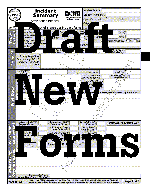 We are
currently toiling to make a new and much better SAR forms packet for
Pennsylvania -- but the work is going
slowly. As things progress, I will post updated information here.
Of course,
we welcome suggestion for improvement of the packet. Here are
some of the documents
for this work-in-progress:
We are
currently toiling to make a new and much better SAR forms packet for
Pennsylvania -- but the work is going
slowly. As things progress, I will post updated information here.
Of course,
we welcome suggestion for improvement of the packet. Here are
some of the documents
for this work-in-progress:
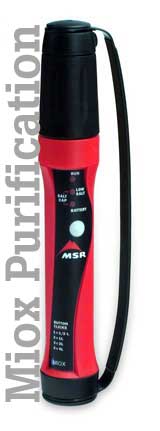 I've recently become enamored of a new water
purification device, and prepared an article that's been published in a
variety of newsletters.
I've recently become enamored of a new water
purification device, and prepared an article that's been published in a
variety of newsletters.
I had laboriously scanned and cleaned up the ICS I-100 Orientation to ICS and posted on the Web in PDF format. Well, finally, you can now download them all from the official ICS document page and browse to your heart's content.
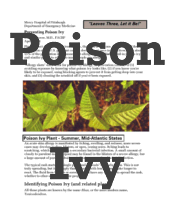
I've never been happy with the available poison ivy information on the web or in other patient handouts. So a couple of years ago, I made up my own. Couldn't get my laptop to print today, so uploaded this here for a patient. But it's of pretty generic interest. Please feel free to use as you wish.
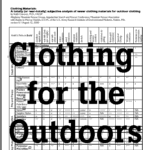 Clothing Materials Table:
Clothing Materials Table: I've always been frustrated by the many manufacturer claims about how great their new clothing materials are – how warm-when-wet, how vapor-permeable, how wicking, how much better than anything else you can buy from someone else. Especially since, to some degree, these new materials are indeed better, in some cases much better, than what we've had before. I have searched the web for objective comparison to no avail. And indeed, a while ago (August 12, 2000) I was in a lecture by a colleague who is probably the world's leading expert on clothing materials, Murray Hamlet, DVM, of the U.S. Army's Research Institute of Environmental Medicine. (He's also a world-class expert and teacher on topics including socks, boots, hypothermia, frostbite, heatstroke, and the use of yaks in warfare, but this particular lecture was about clothing materials.) He was able to give us some good background on clothing materials, some of which I jotted down. But as he said, there is really no good comparison or testing of many of manufacturer's claims.
So, I decided to start and post my own table of outdoor clothing materials. Since August 2000, I've had lots of I first posted it in comments and suggestions, which are reflected in the table and attendant text and footnotes.
Remember, these are personal impressions. If you disagree in major ways or think I made a mistake, email me – I may or may not believe you, but if you have a good comment, I'll include it.
Hope that you find this useful, or at least entertaining!
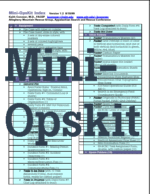 Every
Group of the Appalachian Search and Rescue Conference has a large
OpsKit with
maps, forms, and the various paraphernalia used to run a SAR Operation.
However,
most ASRC members who are involved in running SAR operations carry some
sort of
a mini-OpsKit in their cars, just in case they're the first one to the
scene. I finally wrote up what I keep in mine, just to make it
easier to
restock it after an operation. Click on the icon above to see the
Adobe
Acrobat version, or here to download
the MS
Word 2000 version. Current version is 1.2, dated 8/16/99.
Comments and
suggestions are welcome.
Every
Group of the Appalachian Search and Rescue Conference has a large
OpsKit with
maps, forms, and the various paraphernalia used to run a SAR Operation.
However,
most ASRC members who are involved in running SAR operations carry some
sort of
a mini-OpsKit in their cars, just in case they're the first one to the
scene. I finally wrote up what I keep in mine, just to make it
easier to
restock it after an operation. Click on the icon above to see the
Adobe
Acrobat version, or here to download
the MS
Word 2000 version. Current version is 1.2, dated 8/16/99.
Comments and
suggestions are welcome.
Click here to read it on-line, or here for a MS Word 7 version.
I just (4/27/98) took the first half of a very good "Practical Search Operations" class – a follow-on to the MSO or MSF class – by Dave Carter and Mark Eggeman of Search and Rescue Training Associates of Virginia (also members of the ASRC’s Tidewater SAR Group). This is a great course, sort of "everything about search you wanted to know, but never learned from MSO." The course is specific to Virginia but we’re trying to adapt it to Pennsylvania. It’s sort of a dogmatic course, but consciously so – the point is not that this is not the only good way to do a search, but it is a very good way to run it, and there are advantages to having a single "book way" to run the nitty-gritty details of the search.
As I was taking notes, I couldn’t help noting the parallel with Sun Tzu’s Art of War – dogmatic rules encapsulating expert experience. Now Sun Tzu also has some generic information on leadership, as well as specific tactical information – some of which seems to apply pretty well if you substitute "search" for "war."
I happened to have an copy of the Art of War handy. So I thought I’d take some of the PSO rules, mix them up with a free translation of the relevant part of The Art of War, and what resulted: a pastiche of Sun Tzu and SARTA material. Since, during the time The Art of War was written, it was common to take the teachings of a wise master, add one’s own ideas, and attribute to the master, I’m in good company in what I did, I guess <g>.
As this is an act of art, not science or technical writing, I will be happy to accept suggestions for improvement (kconover+@pitt.edu), and will post updates on my Web site (www.pitt.edu/~kconover) but reserve the right to scream "no, no, NO!", drum my heels on the floor, and refuse to make changes without any other justification.
My apologies to both Sun Tzu and SARTA, and also my apologies for maybe starting a new religion. Hope you find it at least amusing. Click here to read it on-line, or here for a MS Word 7 version.
This is something Art Dodds, of ASRC/MRA/NCRC/FAA fame, sent me. It is a clear plastic ruler designed for measuring latitude and longitude on a topo or sectional map. There is no copyright (I think the company gives them away as freebies) so I scanned the stick (571,431 bytes) and the instructions (197,443 bytes). I've included all their advertising so I doubt they'll mind <g>. If you print the "stick" on a laser transparency, you can cut it out, fold it over and keep it in your pocket in the field. You'll need to have lat/long lines drawn on your topo maps, but that shouldn't be too hard to do ahead of time.
Back in the 70's, Rita Cloutier, Ray Cole, Gene Harrison, and I formed the Appalachian Search and Rescue Conference. The ASRC has done well since then, and has grown far beyond what we (or at least I) imagined. Here is a general blurb about the ASRC, and a link to some ASRC and other Search and Rescue pages:
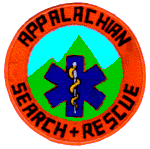 The Appalachian
Search and Rescue Conference (ASRC)
is a volunteer search and rescue organization. ASRC missions include
wilderness search for
lost persons and the rescue of injured persons from hiking, hunting, or
other accidents.
The ASRC also conducts special technical operations including mountain
and cliff rescue.
With over 400 active members, the ASRC is one of the largest (if not
THE largest)
organization devoted solely to wilderness and backcountry search and
rescue. There are
ASRC Groups in Pennsylvania, Virginia, West Virginia, Maryland, Ohio, and Delaware. Though
the ASRC is divided
into several different Groups, all groups share the ASRC Articles of
Incorporation, the
ASRC Bylaws, the ASRC Training Standards, and the ASRC Uniform. Some ASRC
Groups also are part
of the Appalachian Region of the Mountain Rescue Association. The ASRC
is affiliated with
the Eastern Region of the National Cave Rescue Commission (the
organizations have a mutual
aid agreement) and the National Association for Search and Rescue.
The Appalachian
Search and Rescue Conference (ASRC)
is a volunteer search and rescue organization. ASRC missions include
wilderness search for
lost persons and the rescue of injured persons from hiking, hunting, or
other accidents.
The ASRC also conducts special technical operations including mountain
and cliff rescue.
With over 400 active members, the ASRC is one of the largest (if not
THE largest)
organization devoted solely to wilderness and backcountry search and
rescue. There are
ASRC Groups in Pennsylvania, Virginia, West Virginia, Maryland, Ohio, and Delaware. Though
the ASRC is divided
into several different Groups, all groups share the ASRC Articles of
Incorporation, the
ASRC Bylaws, the ASRC Training Standards, and the ASRC Uniform. Some ASRC
Groups also are part
of the Appalachian Region of the Mountain Rescue Association. The ASRC
is affiliated with
the Eastern Region of the National Cave Rescue Commission (the
organizations have a mutual
aid agreement) and the National Association for Search and Rescue.
The local group in the area where I now live is the Allegheny Mountain Rescue Group.
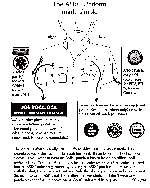 Here is a description of the ASRC uniform, based on
the
official votes at meetings of the ASRC General Membership and Board of
Directors. There is also an
Adobe Acrobat version. For those who are
emergency physicians, there are emergency
physician patches for
the right shoulder.
Here is a description of the ASRC uniform, based on
the
official votes at meetings of the ASRC General Membership and Board of
Directors. There is also an
Adobe Acrobat version. For those who are
emergency physicians, there are emergency
physician patches for
the right shoulder.
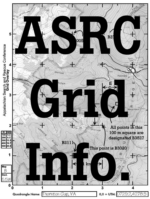 A short treatise on the ASRC Grid
System in Adobe Acrobat form is available by clicking on the picture of
the gridded map or
A short treatise on the ASRC Grid
System in Adobe Acrobat form is available by clicking on the picture of
the gridded map or
![]() here. At
800K it's a bit big, but
it has a couple of big maps in it. Because I did it with Acrobat
Distiller rather than
Acrobat PDF writer (to make the pictures look better), the fonts are a
bit fuzzy on the
screen but seem to print OK.
here. At
800K it's a bit big, but
it has a couple of big maps in it. Because I did it with Acrobat
Distiller rather than
Acrobat PDF writer (to make the pictures look better), the fonts are a
bit fuzzy on the
screen but seem to print OK.
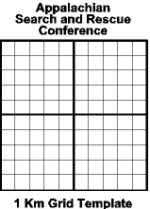 Here also is an Adobe
Acrobat page
Here also is an Adobe
Acrobat page
![]() to print yourself a bunch of these
little
templates to carry in the field when using the ASRC Grid System. Just
photocopy or print
onto a transparency and then cut into little squares. Here'ss a .JPG
version if you're in a hurry; not quite as crisp but you can click
on the link and
then hit your browser's "Print" button.
to print yourself a bunch of these
little
templates to carry in the field when using the ASRC Grid System. Just
photocopy or print
onto a transparency and then cut into little squares. Here'ss a .JPG
version if you're in a hurry; not quite as crisp but you can click
on the link and
then hit your browser's "Print" button.
If you want something fancier, check the link to John Carnes' "1:24,000 MapTools" that you can download and print on a transparency master. Much classier than that I made. Tough the ones I made are OK and usable, John's are clearly the high-class version. Impress your SAR friends by carrying one in your map case.
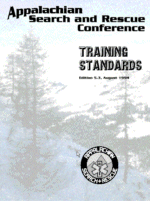 The ASRC has a fairly
rigorous set of standards, perhaps the most stringent of any US. SAR
team, and a rigorous
testing program.
The ASRC has a fairly
rigorous set of standards, perhaps the most stringent of any US. SAR
team, and a rigorous
testing program.
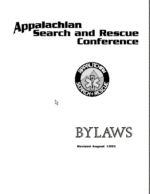 The ASRC is remarkable in that it can
keep as close a coordination as it does between nine different Groups
spread over four
states. Considering the fact that many of the ASRC's members are very
independent-minded
outdoor types, this is even more remarkable. Click on the front page of
the bylaws to the
left orhere to view
or download an Adobe
PDF file of the ASRC Bylaws. This is the newest version of the ASRC
Bylaws..
The ASRC is remarkable in that it can
keep as close a coordination as it does between nine different Groups
spread over four
states. Considering the fact that many of the ASRC's members are very
independent-minded
outdoor types, this is even more remarkable. Click on the front page of
the bylaws to the
left orhere to view
or download an Adobe
PDF file of the ASRC Bylaws. This is the newest version of the ASRC
Bylaws..
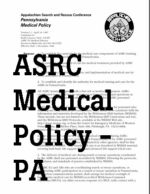 There is a very close
relationship between the ASRC and the Wilderness EMS Institute -- for
one, WEMSI is
co-sponsored by the ASRC. For another, medical direction for the ASRC
is handled by WEMSI
for Pennsylvania.Here is
the ASRC Medical Policy
for Pennsylvania, in Adobe Acrobat form.
There is a very close
relationship between the ASRC and the Wilderness EMS Institute -- for
one, WEMSI is
co-sponsored by the ASRC. For another, medical direction for the ASRC
is handled by WEMSI
for Pennsylvania.Here is
the ASRC Medical Policy
for Pennsylvania, in Adobe Acrobat form.
 I was involved in founding the Virginia and
Pennsylvania Search and Rescue Councils. State SAR Councils have done a
lot to advance search and rescue in
the Mid-Atlantic area. Click on the icon to the left and above for the
PSARC website.
I was involved in founding the Virginia and
Pennsylvania Search and Rescue Councils. State SAR Councils have done a
lot to advance search and rescue in
the Mid-Atlantic area. Click on the icon to the left and above for the
PSARC website.
 Click on the icon for an archive of the
PSARC minutes, back to the earliest times.
Click on the icon for an archive of the
PSARC minutes, back to the earliest times.
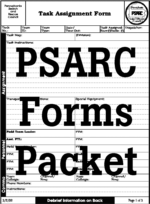 Embarrassing.
Long ago, I created a set of SAR-specific forms. It was a draft to be
discussed by the
member teams of PSARC. But it was adopted, with all its flaws, as the
official PSARC
statewide SAR forms. They have also been used as good examples
nationwide. Here they are
in their original form. They are in Adobe Acrobat .PDF form, which can
be read by the
Adobe Acrobat Reader (currently at version 4.0) or the Acrobat Plugin
for
Netscape/Internet Explorer. The file is a bit big at 600K. Click on the
picture of the
Task Assignment Form (an ASRC invention that has spread worldwide, I'm
glad to say) or here to
view or download.
Embarrassing.
Long ago, I created a set of SAR-specific forms. It was a draft to be
discussed by the
member teams of PSARC. But it was adopted, with all its flaws, as the
official PSARC
statewide SAR forms. They have also been used as good examples
nationwide. Here they are
in their original form. They are in Adobe Acrobat .PDF form, which can
be read by the
Adobe Acrobat Reader (currently at version 4.0) or the Acrobat Plugin
for
Netscape/Internet Explorer. The file is a bit big at 600K. Click on the
picture of the
Task Assignment Form (an ASRC invention that has spread worldwide, I'm
glad to say) or here to
view or download.
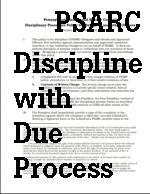 One
problem that occurs to all volunteer SAR organizations (and similar
organizations)
eventually -- a request for formal discipline of a member. But such
disciplinary
proceedings must be carried out with Constitutional protections of due
process in mind.
Here is some material I prepared for the Pennsylvania SAR Council --
this is the draft
version with footnotes and comments that may be of some use to you. See
also the ER-NCRC
policy, below. Click on the picture of the fine print or
One
problem that occurs to all volunteer SAR organizations (and similar
organizations)
eventually -- a request for formal discipline of a member. But such
disciplinary
proceedings must be carried out with Constitutional protections of due
process in mind.
Here is some material I prepared for the Pennsylvania SAR Council --
this is the draft
version with footnotes and comments that may be of some use to you. See
also the ER-NCRC
policy, below. Click on the picture of the fine print or
![]() here to
view or download an
Adobe Acrobat version of this document.
here to
view or download an
Adobe Acrobat version of this document.
![]() Cave
rescue is a lot of fun (well, the training, anyway, and
supposing you don't mind
mud or hard work). Click here
or on the icon to the left to see some pictures of an actual cave
rescue from the summer
of 1993 (best part was I got off work to go caving).
Cave
rescue is a lot of fun (well, the training, anyway, and
supposing you don't mind
mud or hard work). Click here
or on the icon to the left to see some pictures of an actual cave
rescue from the summer
of 1993 (best part was I got off work to go caving).

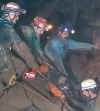 The Eastern
Region NCRC summer weeklong cave rescue training class is the world's
premier place for
cave rescue training. There is also a national weeklong course that
rotates around the
country. (The picture above was taken at the summer 2000
weeklong, both
eastern regional and national combined, by Anmar Mirza.) You can find
out more about cave rescue by checking the Eastern Region, National
Cave Rescue Commission Web site: http://svis.org/erncrc/erncrc.htm.
The Eastern
Region NCRC summer weeklong cave rescue training class is the world's
premier place for
cave rescue training. There is also a national weeklong course that
rotates around the
country. (The picture above was taken at the summer 2000
weeklong, both
eastern regional and national combined, by Anmar Mirza.) You can find
out more about cave rescue by checking the Eastern Region, National
Cave Rescue Commission Web site: http://svis.org/erncrc/erncrc.htm.
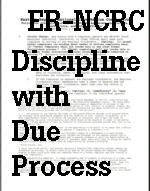 As with PSARC, Eastern
Region NCRC also found a need for a due process policy. It's different
enough due to the
differences in PSARC and NCRC structure to take a look at. Click on the
picture of the
fine print or
As with PSARC, Eastern
Region NCRC also found a need for a due process policy. It's different
enough due to the
differences in PSARC and NCRC structure to take a look at. Click on the
picture of the
fine print or
![]() here to
view or download an
Adobe Acrobat version of this document. The version here is a
penultimate draft,
but I've posted it here as the footnotes and options are
educational. The
final version will be found as part of the ER-NCRC Policy and Procedure
Manual
at the ER-NCRC Web site.
here to
view or download an
Adobe Acrobat version of this document. The version here is a
penultimate draft,
but I've posted it here as the footnotes and options are
educational. The
final version will be found as part of the ER-NCRC Policy and Procedure
Manual
at the ER-NCRC Web site.
There are many kinds of wilderness rescue, but the kind that I like the best is mountain rescue.
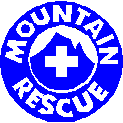 Mountain
rescue can also be fun; though operations tend to occur at 3
AM in the freezing
rain, they also occur in nice weather. At least it's an excuse to get
away from the
computer and into the outdoors. I used to serve as Chair of the Eastern
(now Appalachian)
Region of the Mountain
Rescue Association
(http://www.mra.org), and still train and work with the Allegheny
Mountain Rescue
Group here in Pittsburgh. AMRG is both a local Group of the Appalachian
Search and Rescue
Conference and a certified MRA team. You can email Heather
Houlahan <houlahan+@pitt.edu>, who is the current Allegheny
Mountain Rescue
Group Training Officer, if you're interested in joining or for other
information about
AMRG here in the Pittsburgh area..
Mountain
rescue can also be fun; though operations tend to occur at 3
AM in the freezing
rain, they also occur in nice weather. At least it's an excuse to get
away from the
computer and into the outdoors. I used to serve as Chair of the Eastern
(now Appalachian)
Region of the Mountain
Rescue Association
(http://www.mra.org), and still train and work with the Allegheny
Mountain Rescue
Group here in Pittsburgh. AMRG is both a local Group of the Appalachian
Search and Rescue
Conference and a certified MRA team. You can email Heather
Houlahan <houlahan+@pitt.edu>, who is the current Allegheny
Mountain Rescue
Group Training Officer, if you're interested in joining or for other
information about
AMRG here in the Pittsburgh area..
I'm also active (well, I used to be, and will be again) with ASTM Committee F-32 on Search and Rescue, which you can reach at: http://members.aol.com/mgmsar/f32home.htm
![]()
Betty and I are active with many wilderness, conservation and
related organizations,
and I encourage the rest of you to do so, to. Examples include the Potomac Appalachian Trail Club
![]() and the National
Speleological Society (caving). Indeed, the map fragment that you see
in the background is
a PATC map of the "Hazel Country" section of Shenandoah National Park,
an area
in which I've spent many pleasant hours, some of which were devoted to
the production of
an earlier version of this map.
and the National
Speleological Society (caving). Indeed, the map fragment that you see
in the background is
a PATC map of the "Hazel Country" section of Shenandoah National Park,
an area
in which I've spent many pleasant hours, some of which were devoted to
the production of
an earlier version of this map.
Betty and I both work with our local borough to maintain trails in a small nature reserve near our house. We both like open space in cities, and like to keep the areas primitive except for foot trails for walking, observing nature, and running (not for mountain-biking, that belongs in other places that can take the abuse). We try to maintain the trails to the Potomac Appalachian Trail Club's high volunteer standards.
You may click on the icon for
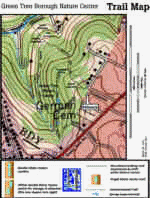 a JPG map of the Green Tree Nature
Center Trail Map
(78K) or,
a JPG map of the Green Tree Nature
Center Trail Map
(78K) or,
click
![]() here for an Adobe
Acrobat .PDF file of the Green Tree Nature Center Trail Map (380K)
here for an Adobe
Acrobat .PDF file of the Green Tree Nature Center Trail Map (380K)
The PDF file is an experiment, first just to see if one can do it with Acrobat (yes) and to see what it looked like. Interestingly, it kept the trails and such as vector graphics, and kept the (touched up) USGS map scan bitmap background as a bitmap. I suppose it might be easier to print with Acrobat, or look better on your printer, than the JPG file. Also, the little bitmap of the trees and mountain and blazes at the bottom center shows up right in the PDF file whereas the colors in the JPG file are something from Andy Warhol, why I have no idea.
I searched the web for a nice "Pack it in, Pack it out" graphic I could download and print to post at the Nature Center. Though I found the very nice Leave No Trace Web site, and stole a couple of their graphics (I don't think they'll mind), I couldn't find exactly what I wanted. So I used a couple of graphics from the LNT and made up my own sign, please feel free to edit and use it yourself. I also asked Mike Yee, a graphically-talented medic with Pittsburgh EMS and our local mountain rescue group, to make up a graphic specifically for this use, and I'll post it here when I can finally persuade him to do it.
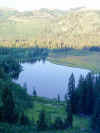 Hiking area:
Wasatch Mountains, Utah
Hiking area:
Wasatch Mountains, UtahHiking area: Appalachian Trail, Northern Virginia, Blackburn Trail Center.
If you haven't seen them already, also look at the page on Ireland and the one on Wales.
 Back to Keith's Home
Page
Back to Keith's Home
Page